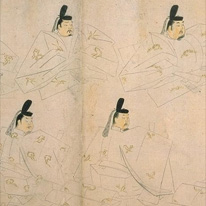Past Exhibitions
- Imperial and Aristocratic Portraiture
- January 26, 2016 - February 21, 2016
It is thought that in ancient times, portrayal of the Imperial family and aristrocrats was shunned as taboo, but there is evidence of it taking place during the era of insei ("cloistered rule," during which Emperors abdicated the throne and entered monasteries, where they continued to wield influence; roughly the late 11th through the late 12th centuries). During the 12th and 13th centuries, the talented portrait artist Fujiwara Takanobu and his son Fujiwara Nobuzane propagated the culture of nise-e ("painted likeness") portraiture, primarily of court nobles. Nise-e painters did not necessarily idealize their subjects, even when the latter were high-ranking aristocrats, and a sense of intimacy is often apparent in their work. On the other hand, throughout the Middle Ages there were a great many grand and imposing portraits of Emperors, created by professional artists as an outgrowth of Imperial involvement with Buddhist temples and Shinto shrines. We hope you enjoy this section's lively and varied depictions of those who bore the burden of command during Japan's medieval period.












